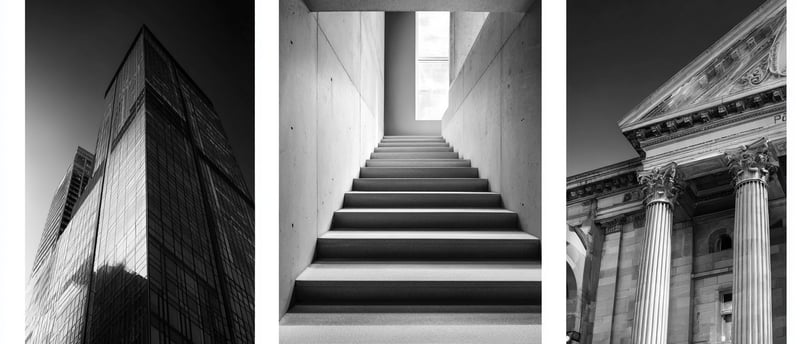Discover Art for Every Space — From Collector Prints to Curated Digital Downloads
What Is Architectural Photography? A Guide with Real-World Examples
BLACK AND WHITE PHOTOGRAPHY INSIGHTS
Gary Washington
3 min read


Understanding the Art of Architectural Photography
Architectural photography is the art of capturing buildings, structures, and spaces in a way that’s both accurate and expressive. It goes beyond documentation. Great architectural photos don’t just show what a building looks like — they reveal its purpose, personality, and power.
From modern skyscrapers to historic cathedrals, architectural photography transforms the built environment into visual storytelling.
What Makes Architectural Photography Unique?
Unlike landscape or portrait photography, architecture doesn't move — but light, shadow, and angles do. The photographer’s job is to turn static subjects into dynamic images through composition, lighting, and detail.
Key Goals of Architectural Photography:
Showcase design and structure
Highlight form, function, and context
Evoke emotion through space and silence
Preserve cultural or historic significance
In other words, it’s not just about taking pictures of buildings — it’s about helping others see them.
Types of Architectural Photography
Architectural photography covers more than just exterior shots. Here are the core subgenres:
1. Exterior Architecture
Focuses on the outer shape, style, and materials of buildings
Often uses natural light, dramatic angles, and leading lines
Includes residential homes, office buildings, monuments, and skyscrapers
2. Interior Architecture
Captures the inside of buildings — often with controlled lighting
Emphasizes layout, mood, and flow of space
Great for real estate, hospitality, and design portfolios
3. Abstract or Fine Art Architecture
Uses elements of a structure (patterns, reflections, textures) to create artistic images
Often overlaps with black and white photography
Focuses less on full context and more on emotion or symbolism
Why Is Architectural Photography Important?
From architects and developers to artists and historians, many rely on architectural photography to:
Document creative work
Market real estate or commercial spaces
Preserve cultural or historic buildings
Showcase minimalist or modern design
For collectors, architectural photography offers something unique — it blends creativity with structure, and emotion with order.
Architectural Photography Examples You Should Know
Here are a few inspiring examples to illustrate what architectural photography can look like in real life:
1. The Stairwell (Black & White)
A spiral staircase captured from above. The shadows and curves turn a functional element into a visual metaphor for motion and mystery.
2. Brutalist Facade at Dusk
The light hits just one corner of a concrete wall, revealing harsh lines and subtle texture. It feels raw and intentional — like the building is speaking.
3. Glass Meets Sky
A high-rise office tower photographed with a tilt-up angle, reflecting clouds across its surface. The shot plays with transparency, power, and repetition.
4. Symmetry Inside a Church
An interior frame where rows of pews and arches lead the eye straight to a stained-glass window. The symmetry feels peaceful and spiritual.
Each of these examples shows how architecture can become more than just structure — it becomes art.
Tips for Taking Great Architectural Photos
If you’re a photographer (or want to understand the artistic process behind what you collect), here are some quick-start tips:
Scout the location first — walk around to understand light and angles
Use a tripod — stability is essential for architectural symmetry
Wait for good light — golden hour and blue hour create mood
Look for patterns and repetition — these are visual gold
Pay attention to verticals — keep lines straight using grid tools or tilt-shift lenses
Shoot in RAW — gives you more control over shadows, highlights, and tone
And if you're shooting in black and white? Focus on light and form — not just the subject.
How Buyers and Collectors Can Appreciate It
You don’t need to be a photographer to love architectural images. Here’s what to look for when buying or curating:
Strong compositions that feel balanced
Clear attention to lighting and texture
Structures that evoke meaning or nostalgia
Limited editions or artist-signed prints
Pieces that complement your design aesthetic
Whether minimalist or modern, architectural art fits seamlessly into almost any space.
Final Thoughts: When Buildings Become Visual Stories
So, what is architectural photography? It's the intersection of design, art, and storytelling. It transforms buildings from spaces we pass by into images we remember.
Through framing, light, and emotion, architectural photographers don’t just capture structures — they capture perspective. For creators, it’s an expressive discipline. For collectors, it’s a timeless investment in visual culture.
Want to Add Architectural Art to Your Space?
Explore our curated gallery of architectural photography — from black and white to fine art abstracts — perfect for modern homes and creative workspaces.
Gain a fine art perspective in What Makes Black and White Photography Good? A Fine Art Perspective on Architectural Prints.
Mr. Washington Gallery
Mr. Washington Gallery showcases striking black and white architectural photography and fine art prints. Rooted in timeless design and thoughtful composition, each piece invites reflection, storytelling, and a deeper connection to the built world.
Quick links
© 2025. All rights reserved.
